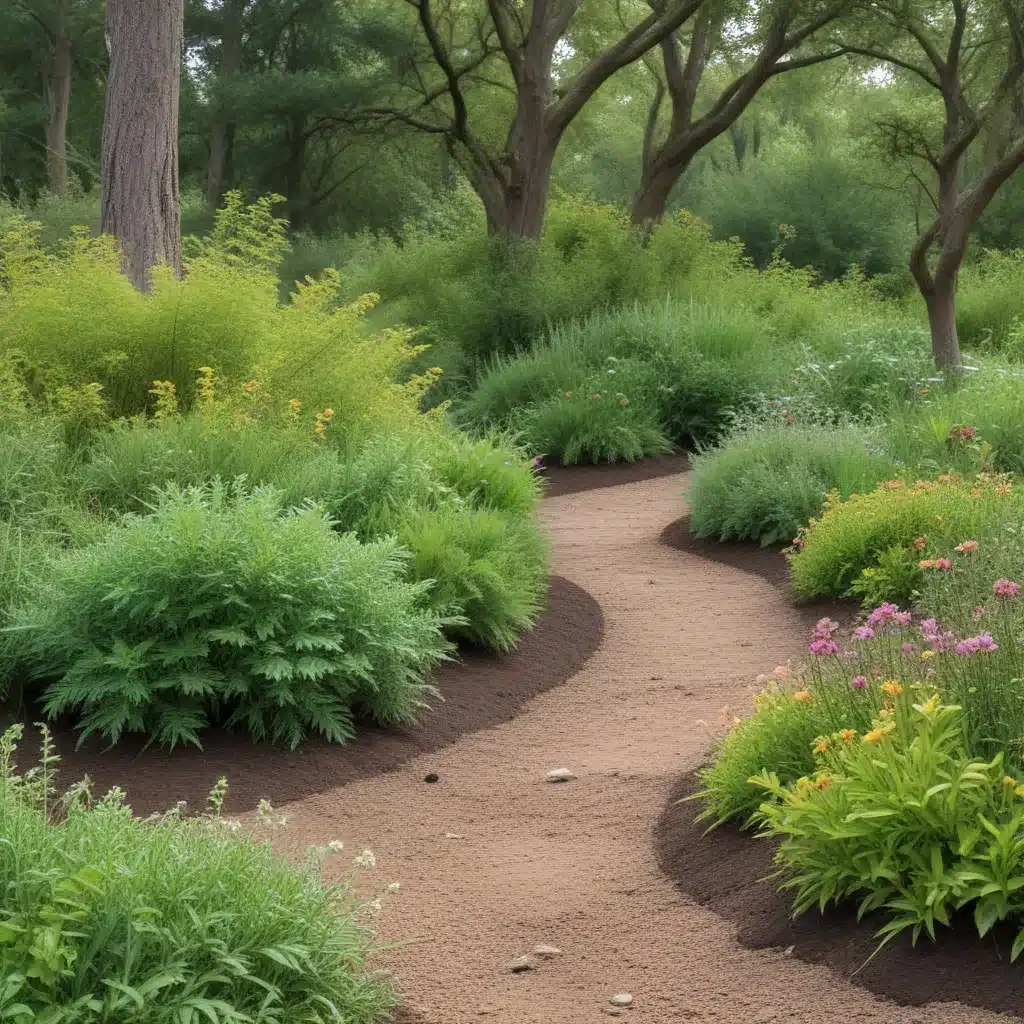
At Crooked Pines Farm, we believe that cultivating a thriving, nature-centric landscape is essential for fostering biodiversity and creating meaningful connections between our community and the great outdoors. As a farm educator, I’m passionate about empowering families to transform their outdoor spaces into wildlife habitats that support a diverse array of local flora and fauna.
Sustainable Landscaping Principles
Embracing sustainable landscaping practices is the foundation for nurturing a healthy, resilient ecosystem right in your own backyard. Let’s explore some key principles to consider.
Ecological Considerations
When designing a sustainable landscape, it’s crucial to prioritize native plants that are well-adapted to the local climate and soil conditions. These indigenous species not only thrive with minimal maintenance but also provide vital food and shelter for native wildlife. By reducing the reliance on exotic ornamentals and water-intensive turf grass, you can create a landscape that is in harmony with the natural rhythms of your region.
Water Conservation Strategies
Water scarcity is a pressing concern, and sustainable landscaping offers solutions to help conserve this precious resource. Incorporating rainwater harvesting systems, drought-tolerant plants, and efficient irrigation methods can significantly reduce your landscape’s water footprint. Permeable surfaces and bioswales also play a role in managing stormwater runoff and promoting groundwater recharge.
Native Plant Selection
Curating a diverse palette of native plants is the keystone of a sustainable landscape. By selecting species indigenous to your area, you’ll not only foster a thriving ecosystem but also reduce the need for chemical fertilizers and pesticides. Prioritize plants that provide nectar and pollen for pollinators, as well as those that offer nutritious berries, seeds, and foliage for birds and other wildlife.
Wildlife-Friendly Gardening
Transforming your landscape into a haven for local wildlife is a rewarding endeavor that benefits both your ecosystem and your connection to nature.
Pollinator-Attracting Plants
Pollinators, such as bees, butterflies, and hummingbirds, play a vital role in the health of our landscapes. By incorporating a variety of nectar-rich flowers, host plants, and sheltering features, you can create a veritable pollinator oasis. Observe which native plants are thriving in your region and consider adding them to your garden for maximum pollinator appeal.
Shelter and Nesting Habitats
Providing shelter and nesting sites for wildlife is essential for supporting a diverse array of species. This could involve installing bird houses, bat houses, and brush piles, as well as leaving dead wood and leaf litter to create valuable microhabitats. By catering to the specific needs of local fauna, you’ll invite a wider range of creatures to take up residence in your landscape.
Integrated Pest Management
Sustainable landscaping embraces integrated pest management (IPM) strategies that prioritize natural, non-toxic solutions to garden challenges. This might include introducing beneficial insects, implementing physical barriers, and promoting cultural controls like hand-picking pests. By fostering a balanced ecosystem, you can minimize the need for harsh pesticides and herbicides, which can harm wildlife and contaminate soil and water.
Biodiversity Enhancement
Enhancing biodiversity is a cornerstone of sustainable landscaping, as it strengthens the resilience and overall health of your ecosystem.
Habitat Connectivity
Creating habitat corridors that link your landscape to neighboring natural areas is crucial for enabling the movement and migration of wildlife. This can involve planting native hedgerows, riparian buffers, or pollinator-friendly pathways that provide continuous cover and resources for animals to thrive.
Invasive Species Control
Vigilantly managing invasive plant species is essential for maintaining the integrity of your native ecosystem. By identifying and removing these aggressive interlopers, you’ll free up valuable space and resources for your desired native plants to flourish. Consider incorporating native alternatives that can outcompete and crowd out invasive species.
Meadow and Prairie Establishment
Transforming a portion of your landscape into a native meadow or prairie can have a profound impact on biodiversity. These diverse, low-maintenance ecosystems support a wide array of pollinators, birds, and small mammals. With thoughtful site preparation and seed selection, you can create a stunning, ever-changing display of blooms and wildlife activity.
Soil Health Management
Healthy soil is the foundation for a thriving, sustainable landscape. By focusing on soil health, you can unlock the full potential of your outdoor space.
Organic Matter Enrichment
Incorporating organic matter, such as compost and leaf litter, is crucial for improving soil structure, nutrient cycling, and water-holding capacity. This, in turn, supports the growth of robust, disease-resistant plants that can better withstand environmental stresses.
Composting and Mulching
Embracing composting and mulching practices helps to suppress weeds, retain soil moisture, and gradually replenish nutrients. By diverting organic waste from landfills and returning it to the ground, you’re closing the loop and creating a more sustainable, regenerative system.
Reduced Chemical Inputs
Minimizing the use of synthetic fertilizers and pesticides is essential for maintaining the delicate balance of your soil ecosystem. These harsh chemicals can disrupt the intricate web of life underground, harming beneficial microorganisms and ultimately compromising the overall health of your landscape. Instead, opt for organic, slow-release amendments and embrace integrated pest management strategies.
As you embark on your sustainable landscaping journey, remember that every effort, no matter how small, can make a world of difference. By nurturing nature in your own backyard, you’re not only creating a vibrant, wildlife-friendly oasis but also contributing to the larger goal of ecological restoration and biodiversity conservation. Explore the resources available at Crooked Pines Farm to further inspire and guide you on this rewarding path.


